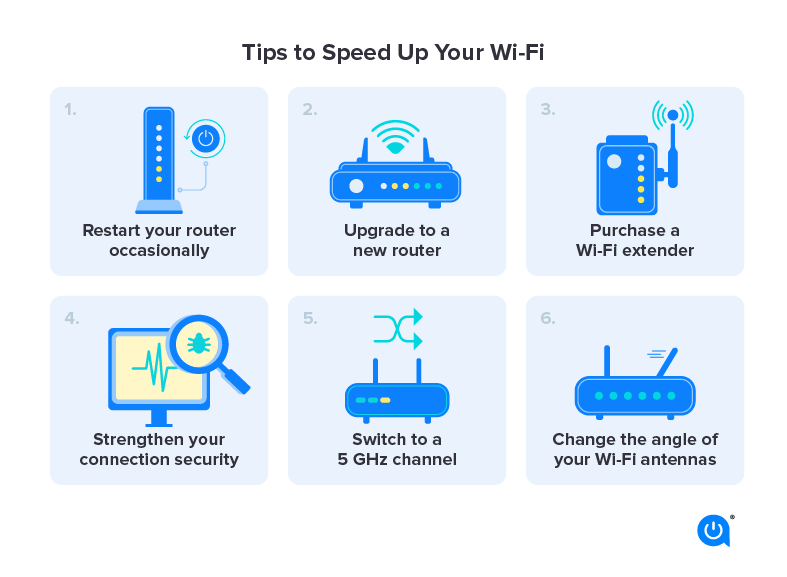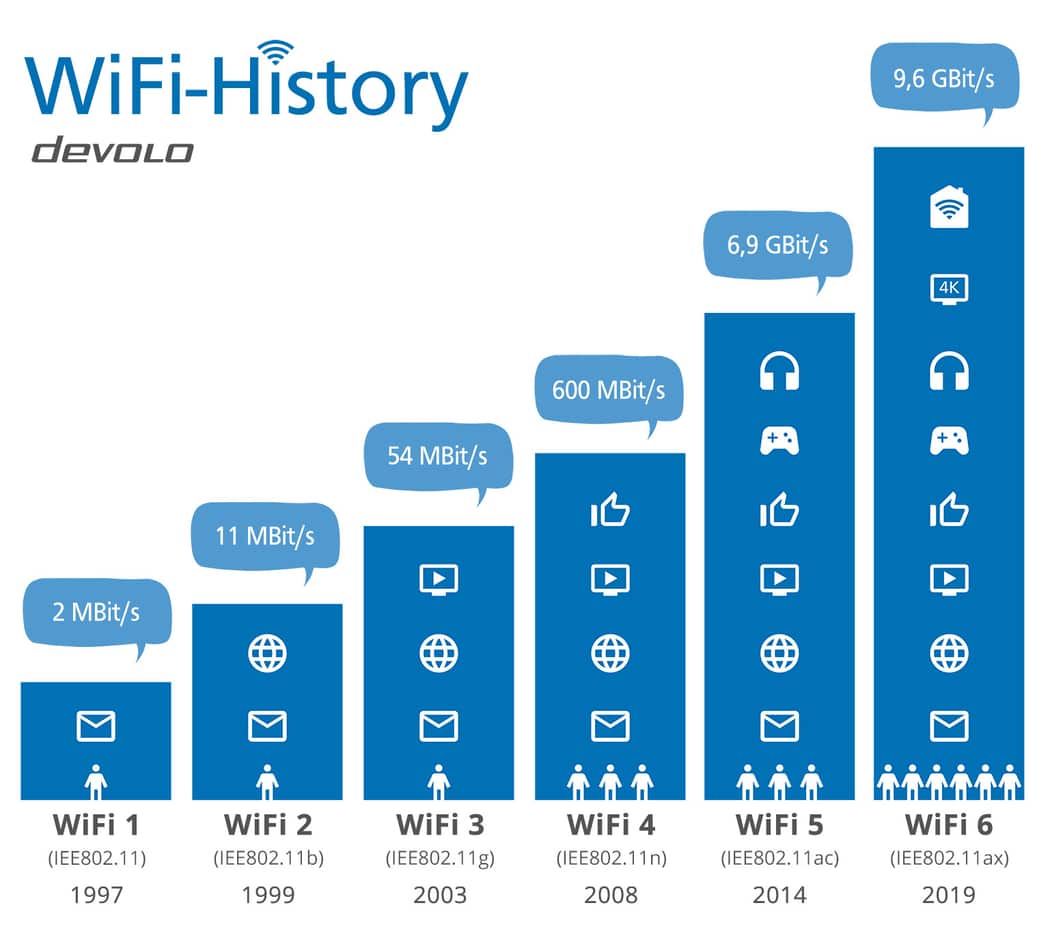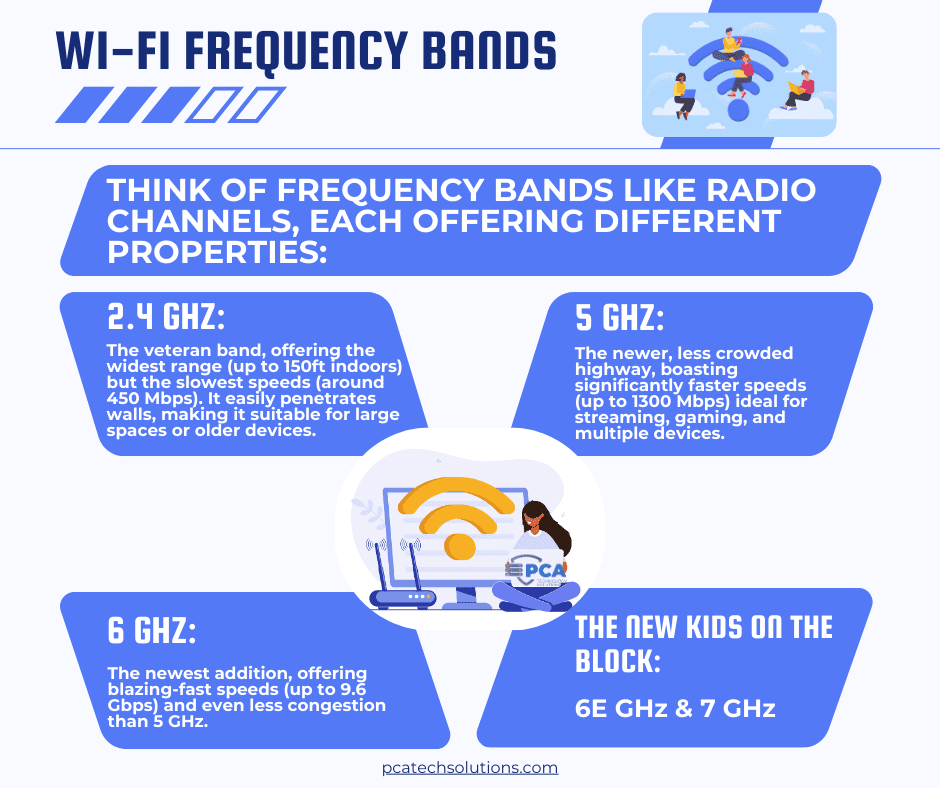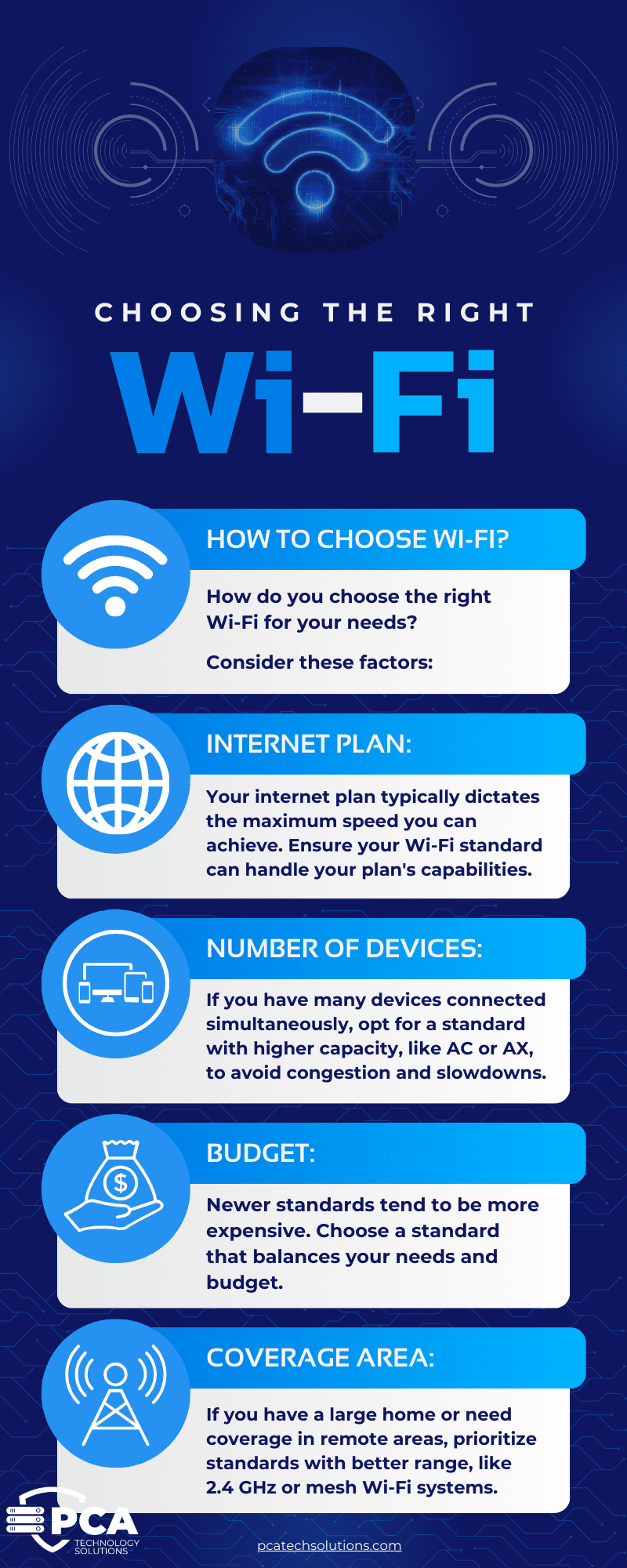Navigating the Waves: A Guide to Wi-Fi
In today’s hyper-connected world, Wi-Fi has become an essential utility, powering our work, entertainment, and communication.
Turn on “Wi-Fi” on your device, click connect, and voila, you are connected to the internet. No problem, right?
Well…sort of.
With numerous standards and acronyms floating around, choosing the right type of Wi-Fi for your needs can feel like deciphering a foreign language.
But, fear not!
We have attempted to provide a clear guide that will equip you with the knowledge to navigate the different Wi-Fi waves to select the one that best suits your needs.
First things first:
-
- Wi-Fi is not the internet. Internet is not Wi-Fi.
- Just because Wi-Fi is “down,” this doesn’t mean the internet is down.
- Just because the Wi-Fi is “up,” this doesn’t mean the internet is up.
- Just because you have a full signal, this doesn’t mean you are going to have a great experience.
- A good signal doesn’t always mean “good” Wi-Fi.
This blog will cover:
- Wi-Fi Progress
- Demystifying the Alphabet Soup
- Infrastructure Challenges
- Interference Gremlins
- What is “Wi-Fi standard?”
- Choosing the Right Wi-Fi
- Solutions for Better Wi-Fi Coverage
- Tools and methods for determining Wi-Fi needs
- Conclusion

Wi-Fi Progress
One notable development in the realm of Wi-Fi technology is the introduction of the 6 GHz band for unlicensed use.
In April 2020, the Federal Communications Commission (FCC) in the United States voted to open up the 6 GHz band (specifically the 5.925–7.125 GHz range) for unlicensed Wi-Fi and other unlicensed uses.
This decision significantly expanded the available spectrum for Wi-Fi networks, potentially alleviating congestion in existing bands and enabling faster speeds and better performance for wireless networks.
The introduction of Wi-Fi 6E, which operates in the 6 GHz band, builds upon this regulatory change. Wi-Fi 6E routers and devices began to enter the market in 2021, taking advantage of the newly available spectrum to deliver higher speeds, lower latency, and better overall performance.
Additionally, ongoing efforts in spectrum management and wireless regulation by organizations such as the FCC and the Institute of Electrical and Electronics Engineers (IEEE) may lead to future changes and updates that could impact Wi-Fi technology and its regulatory environment.
It’s essential for businesses, consumers, and stakeholders in the Wi-Fi ecosystem to stay informed about regulatory developments, as they can influence the deployment, operation, and use of Wi-Fi networks. Keeping abreast of changes in regulations and standards ensures compliance and helps maximize the benefits of Wi-Fi technology.


Demystifying the Alphabet Soup:
Wi-Fi standards are classified by letters like A, B, G, N, AC, and AX. These letters represent different versions of the IEEE 802.11 standard, each offering improvements over its predecessor in terms of speed, range, and capacity.
Here’s a quick breakdown:
- Wi-Fi 4 (802.11n): The workhorse of the past decade, offering reliable speeds for basic internet tasks. Operates on both 2.4 GHz and 5 GHz frequencies.
- Wi-Fi 5 (802.11ac): A significant upgrade, providing faster speeds and better handling of multiple devices. Primarily operates on the less congested 5 GHz band.
- Wi-Fi 6 (802.11ax): The latest and greatest, boasting even faster speeds, lower latency, and improved efficiency for crowded networks. Operates on both 2.4 GHz and 5 GHz frequencies, including a new 6 GHz band.
Details Matter:
- Speed: Measured in Mbps (megabits per second), this indicates how much data can be transferred per unit time. Older standards like B offered speeds up to 11 Mbps, while the latest AX standard boasts speeds exceeding 10 Gbps.
- Range: This refers to the distance your device can be from the router while maintaining a good connection. 2.4 GHz generally offers better range, while 5 GHz provides better speed at shorter distances.
The Big Three: Range vs. Speed
Think of frequency bands like radio channels, each offering different properties:
-
- 2.4 GHz: The veteran band, offering the widest range (up to 150ft indoors) but the slowest speeds (around 450 Mbps). It easily penetrates walls, making it suitable for large spaces or older devices. However, its popularity leads to high congestion and frequent interference.
- 5 GHz: The newer, less crowded highway, boasting significantly faster speeds (up to 1300 Mbps) ideal for streaming, gaming, and multiple devices. However, its shorter radio waves result in a shorter range (30-70ft indoors), making it less suitable for expansive areas.
- 6 GHz: The newest addition, offering blazing-fast speeds (up to 9.6 Gbps) and even less congestion than 5 GHz. However, its availability is still limited due to fewer compatible devices and routers.

The New Kids on the Block: 6E GHz and 7 GHz
-
- 6E GHz: Essentially an extension of the 6 GHz band, utilizing additional channels for even more speed and capacity. Its availability is even more limited than 6 GHz at present.
- 7 GHz: Still in its early stages, this band promises ultra-high bandwidth (up to 46 Gbps) for future-proof applications. However, commercialization is still years away.

Beyond the Basics:
-
- Dual-band routers: Support both 2.4 GHz and 5 GHz, offering flexibility for different devices and needs.
- Mesh Wi-Fi systems: Multiple access points work together to eliminate dead zones and provide seamless coverage in large homes.
- Guest networks: Create a separate network for visitors, protecting your privacy and security.
Several factors can wreak havoc on Wi-Fi coverage in offices and warehouses, leading to frustration and lost productivity.
Here are some of the most common culprits:
Infrastructure Challenges:
-
- Physical Obstructions: Walls, metal structures, and even furniture can significantly weaken the signal, creating dead zones and connectivity issues. In warehouses, towering shelves and stacked inventory can act as major barriers.
- Incorrect Access Point Placement: Poor positioning of access points (APs) can lead to uneven coverage or signal overlap, causing interference and slowdowns. In large spaces, strategic placement with overlapping coverage is crucial.
- Insufficient Number of APs: Trying to cover a large area with too few APs will inevitably result in weak or nonexistent signal in certain areas. Warehouses with dynamic stock levels and changing layouts require careful planning for sufficient AP coverage.
- Older routers and access points: They may not support newer Wi-Fi standards (like 5 GHz or 6 GHz) or offer features like beamforming for better signal targeting.
- Outdated client devices: Devices with older Wi-Fi adapters may not be compatible with newer standards or lack the range to connect effectively.
Other Considerations:
-
- Router compatibility: Ensure your router supports the chosen Wi-Fi standard.
- Device compatibility: Check if your devices can connect to the specific Wi-Fi type.
- Budget: Newer standards typically come at a higher price point.
- Device Limitations: Older devices might not support newer Wi-Fi standards, leading to compatibility issues and slower speeds.
- Environmental Factors: Extreme temperatures, humidity, and dust can impact the performance and lifespan of APs. Warehouses with harsh environments may require specialized equipment.
- Security Misconfigurations: Improper network security settings can leave the network vulnerable to interference and unauthorized access, impacting performance and stability.
What is “Wi-Fi standard?”
The term “Wi-Fi standard” refers to a set of technical specifications and protocols established by the Institute of Electrical and Electronics Engineers (IEEE) for wireless local area networking (WLAN) technology. These standards define the rules and requirements that Wi-Fi devices must follow to communicate with each other and operate within a Wi-Fi network.
Each Wi-Fi standard is identified by an IEEE designation, such as 802.11 followed by a letter (e.g., 802.11b, 802.11g, 802.11n, 802.11ac, 802.11ax, etc.). These letters typically denote the version or iteration of the standard and may also indicate specific enhancements or improvements over previous versions.
Wi-Fi standards specify various parameters and features, including:
-
- Operating Frequency: The frequency bands (e.g., 2.4 GHz, 5 GHz, 6 GHz) used for wireless communication.
- Data Rates: The maximum theoretical data transfer rates supported by the standard, typically measured in megabits per second (Mbps) or gigabits per second (Gbps).
- Modulation Techniques: The methods used to encode and decode data for transmission, such as Orthogonal Frequency-Division Multiplexing (OFDM) or Orthogonal Frequency-Division Multiple Access (OFDMA).
- Channel Width: The width of frequency channels used for communication, which can impact data throughput and network performance. (Think number of lanes on the highway or size of a water pipe. Bigger pipe/more lanes = greater ability to handle more volume.)
- Security Protocols: The security mechanisms and encryption standards used to protect data transmitted over Wi-Fi networks, such as WPA2, WPA3, etc.
- Backward Compatibility: Whether the standard is backward-compatible with previous versions, allowing devices supporting different iterations of the standard to communicate with each other. (i.e. Will your 5-year-old XBox still work with your new, latest, greatest Wi-Fi router?)
New Wi-Fi standards are developed periodically to address emerging technologies, improve performance, enhance security, and accommodate increasing demands for wireless connectivity. As a result, newer Wi-Fi standards often offer faster speeds, greater range, and better reliability compared to older ones.
Understanding Wi-Fi standards is crucial for selecting compatible devices, optimizing network performance, and ensuring interoperability within Wi-Fi networks. It also helps users make informed decisions when purchasing routers, access points, and other Wi-Fi-enabled devices.

Choosing the Right Wi-Fi:
Now that you understand the basics, how do you choose the right Wi-Fi for your needs? Consider these factors:
- Internet plan: Your internet plan typically dictates the maximum speed you can achieve. Ensure the Wi-Fi standard of your devices can handle your plan’s capabilities.
- Number of devices: If you have many devices connected simultaneously, opt for a standard with higher capacity, like AC or AX, to avoid congestion and slowdowns.
- Budget: Newer standards tend to be more expensive. Choose a standard that balances your needs and budget.
- Coverage area: If you have a large home or need coverage in remote areas, prioritize standards with better range, like 2.4 GHz or mesh Wi-Fi systems.
Remember: It’s not just about speed. Choose a standard that fits your overall usage patterns and device compatibility.
Bonus Tip: Security is key! Always enable WPA2 or WPA3 encryption on your Wi-Fi network to protect your data from unauthorized access.
Solutions for Better Wi-Fi Coverage:
-
- Conduct a Wi-Fi site survey: Identify coverage gaps, interference sources, and optimal AP placement.
- Deploy additional access points: Ensure adequate coverage throughout the space, considering walls and obstructions.
- Position APs strategically: Place them in open areas, away from walls and obstructions, with proper antenna orientation.
- Upgrade equipment: Invest in newer routers and APs that support the latest Wi-Fi standards and offer features like beamforming.
- Manage channel usage: Choose non-overlapping channels and utilize channel management features.
- Keep firmware updated: Regularly update firmware on routers and APs for improved performance and security.
- Consider mesh Wi-Fi systems: These offer multiple interconnected APs for seamless coverage and improved performance in large spaces.
By addressing these factors and implementing appropriate solutions, you can significantly improve Wi-Fi coverage in your office or warehouse, ensuring a smooth and productive work environment.
Do you have a business that is moving to a new space? Are you having consistent Wi-Fi issues that need to be resolved? Or do you want to start fresh?
Determining a building’s Wi-Fi needs for access points, GHz frequency, and other factors requires a comprehensive assessment of various factors such as building size, layout, materials, usage patterns, and potential sources of interference.
Several tools and methods are available to assist in this process:
Wi-Fi Site Survey Tools: These tools help assess the wireless environment within a building by measuring signal strength, interference levels, and coverage areas. They provide valuable insights into Wi-Fi performance and help identify areas with poor coverage or high interference. Examples of Wi-Fi site survey tools include:
-
- Ekahau Site Survey
- NetSpot
- Acrylic Wi-Fi Heatmaps
- TamoGraph Site Survey
RF Spectrum Analyzers: RF spectrum analyzers detect and analyze radio frequency signals in the environment, helping identify sources of interference that could impact Wi-Fi performance. They provide information on signal strength, noise levels, and channel utilization, aiding in the selection of optimal Wi-Fi channels and frequencies. Popular RF spectrum analyzer tools include:
Wireless Access Point Placement Tools: These tools simulate the placement of wireless access points (APs) within a building to optimize coverage and minimize dead zones. They take into account factors such as building layout, materials, and signal propagation characteristics to recommend the ideal placement of APs. Examples of access point placement tools include:
-
- Cisco Wireless Network Design Tool
- Aruba RF Plan
- Aerohive Planner
Wi-Fi Planning Software: Wi-Fi planning software allows for the design and simulation of Wi-Fi networks based on specific requirements and constraints. Users can create virtual models of buildings, add APs, adjust parameters, and analyze network performance before deployment. Some popular Wi-Fi planning software includes:
-
- iBwave Wi-Fi
- Ekahau Wi-Fi Planner
- Cisco Wireless Network Solution Engine (WNSE)
Network Monitoring Tools: Network monitoring tools continuously monitor Wi-Fi performance in real-time, providing insights into network health, usage patterns, and potential issues. They help identify bottlenecks, monitor device connectivity, and troubleshoot connectivity problems as they arise. Examples of network monitoring tools include:
Professional Wi-Fi Consultants: For complex or large-scale deployments, hiring professional Wi-Fi consultants or engineers can provide invaluable expertise and experience in assessing Wi-Fi needs, designing network architectures, and optimizing performance. These professionals can conduct on-site surveys, analyze data, and recommend customized solutions tailored to specific requirements.
By leveraging these tools and resources, building owners, IT administrators, and Wi-Fi professionals can accurately assess a building’s Wi-Fi needs, design robust network infrastructures, and ensure optimal performance and reliability for users.
Conclusion
Understanding the different types of Wi-Fi, common problems, and GHz Wi-Fi channels can help users optimize their home or office networks for better performance and reliability.
By choosing the right Wi-Fi standard, selecting the appropriate frequency band, and configuring optimal channel settings, users can ensure a seamless and enjoyable online experience.
Additionally, addressing common issues such as interference and congestion can further enhance Wi-Fi performance, providing faster speeds and more reliable connections for all devices.
Need help?
Even with all these explanations, we recognize that it often feels like you need a degree in Wi-Fi technology to figure out what your business actually needs.
You don’t want to buy a Ferrari if you only need a Lexus, and why buy a Lexus if a Toyota is all you need! However, just like we have basically resigned ourselves to buying a new cell phone every 2-4 years, Wi-Fi technology is also improving at lightning speed, so keep this in mind when making technology investments. Upgrades will still be required. There’s just no way around it!
PCA Technology Solutions has the right technology and software to deploy to accurately determine exactly what your business and building needs for Wi-Fi that doesn’t just work – it will work well. We also have employees with the right training to utilize this technology. Contact us today if you would like to learn more about how we can assist you.

Eric Huffstutler
Solutions Professional, PCA Technology Solutions
Eric Huffstutler is a Solutions Professional at PCA Technology Solutions, where he has been a dedicated employee since October 2016.
Eric specializes in Wi-Fi assessment and design for business spaces.

